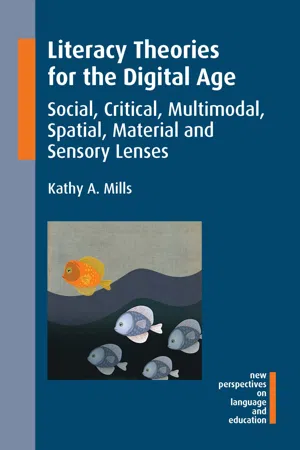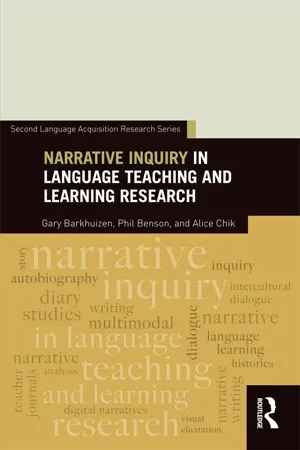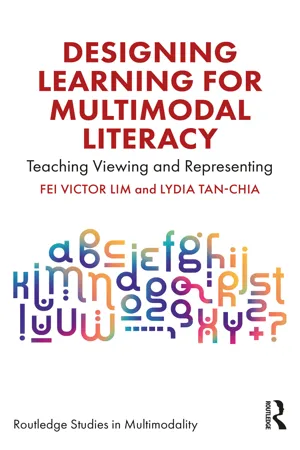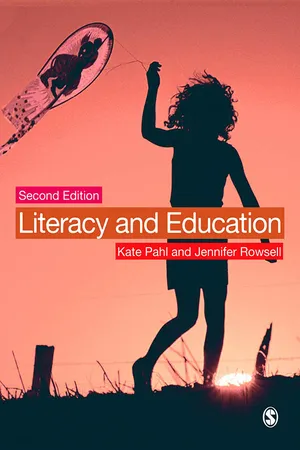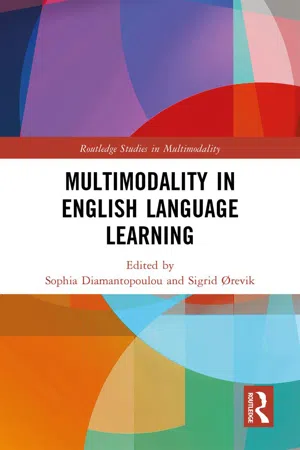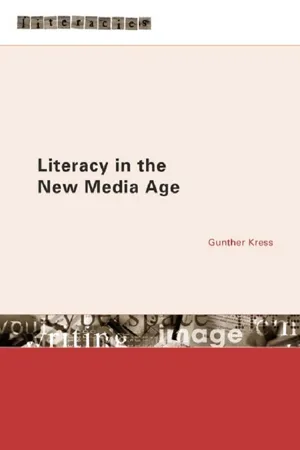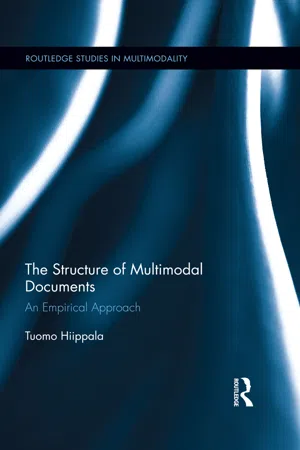Languages & Linguistics
Multimodal Texts
Multimodal texts refer to communication that involves the use of multiple modes or forms of expression, such as written language, images, sounds, and gestures. These texts are designed to convey meaning through a combination of different elements, allowing for a richer and more nuanced communication experience. Multimodal texts are commonly found in various media, including advertisements, websites, and multimedia presentations.
Written by Perlego with AI-assistance
Related key terms
Related key terms
1 of 4
Related key terms
1 of 3
11 Key excerpts on "Multimodal Texts"
- eBook - ePub
Literacy Theories for the Digital Age
Social, Critical, Multimodal, Spatial, Material and Sensory Lenses
- Kathy A. Mills(Author)
- 2015(Publication Date)
- Multilingual Matters(Publisher)
4 Multimodal Literacies A multimodal approach to technology-mediated learning offers a way of thinking about the relationship between semiotic resources and people’s meaning making (Jewitt, 2006: 16) Key Concepts of Multimodal Literacies Multimodal approaches to literacy are currently prolific in educational research, indicated by the steady increase in the number of research studies of digitally mediated literacy practices (Mills, 2009). The popular terms ‘multimodal’ and ‘literacy’ now appear together in over 30,000 scholarly texts accessible to Google Scholar, though definitions of multimodality are not always alike. The dominant theory of multimodality addressed in this chapter is positioned within the theoretical framework of social semiotics (Kress & van Leeuwen, 2006). Social semiotics explicitly attends to meaning-making of diverse kinds, whether of words, actions, images, somatic meanings or other modes (Thibault, 1993). Therefore, by definition, social semiotics acknowledges the role of non-linguistic modes in human social meaning. Multimodality is defined as ‘... the use of several semiotic modes in the design of a semiotic product or event’ (Kress et al., 2001: 20). Reading and writing have always been multimodal, since these literate practices involve the decoding and encoding of words, while similarly attending to spatial layout of the text, images and other modes of representation (e.g. gestural meanings of represented characters, material features of the book). Yet undeniably, people-driven technological developments of communication have given rise to a much more diverse range of texts and textual practices - Gary Barkhuizen, Phil Benson, Alice Chik(Authors)
- 2013(Publication Date)
- Routledge(Publisher)
The literacy narratives by Barry and Porter both included visual components to complement and enrich their written narrative texts. In language learning research, also, we have begun to see the use of multimodal narrative texts as alternatives or supplements to the more traditional written and spoken narratives covered in the previous two chapters. Multimodal Texts can be used as subject (e.g., Barry, 2002) or as tool (e.g., Porter, 2002). As subject, the multimodal text is meant to be the end product and is the main set of data for narrative analysis. This is similar to the collection of written data for analysis, with additional photographs or drawings or hyperlinks inserted. As tool, the multimodal text is used as an artifact during interviews, in which the author (usually a language learner) discusses language learning with reference to the multimodal text. Here, the multimodal text is a prop, and it may or may not be analyzed independently. Compared to oral and written elicitation, the number of narrative analysis studies adopting Multimodal Texts either as subject of investigation or tools for investigation is comparatively small. However, there is a growing number of studies which are based on multimodal narratives in second language education. In this chapter, we look at digital and non-digital Multimodal Texts as subjects of and tools for narrative inquiry in language teaching and learning.4.2 Contexts in which Multimodal Narrative Texts are Used
This chapter is concerned with multimodal data collection in narrative inquiry. We adopt Kress’s definition of mode as that of “culturally and socially produced resources for representation” (2005: 6). Kress gives the examples of image, writing, music, layout, and others as different modes that people use to make and communicate meanings. Therefore, in this chapter, we consider narratives constructed by more than one mode as multimodal narratives; for instance, written narratives embedded with hyperlinks or photographs, or oral narratives supported or supplemented by photographs. In addition, “multimedia text” has been used by narrative researchers, a term used frequently in Computer-Assisted Language Learning research. Beatty (2010) defines multimedia texts as texts that include several media types; e.g., text, images, sound, or video. Multimedia text embraces both “the non-linear organization of text” and “non-linear and multiple information formats” (p. 45). Throughout the chapter, we will use both terms interchangeably. Definitions aside, our main focus is on the different ways narrative researchers appropriate multimodal/multimedia texts for data collection in narrative research.As in studies using oral and written data, multimodal data are produced and collected in different contexts. The following outlines in more detail the contexts in which such data are produced and collected. The studies chosen here are categorized according to two criteria: either the authors themselves used the term “multimodal” or “multimedia” to describe their data, or we deemed the data to be “multimodal” or “multimedia.” Studies that have been referenced as examples are discussed in more detail later in the chapter.- eBook - ePub
Designing Learning for Multimodal Literacy
Teaching Viewing and Representing
- Fei Victor Lim, Lydia Tan-Chia(Authors)
- 2022(Publication Date)
- Routledge(Publisher)
3 Multimodal Literacy Learning with Print TextsDOI: 10.4324/9781003258513-33.1 Why Teach Multimodal Literacy with Print Texts?
As you read the lines on this page, you would notice that the meanings are not just expressed through the content of the words in the paragraphs. The heading of the chapter at the top of this page, the subheadings introducing new paragraphs, the numbering at the bottom of the page, and even the materiality of the book before you – be it physical or digital – offer additional information about the content of what you are reading and about to read.The texts that we encounter in our daily lives are always multimodal – expressing meanings not only with words but also how words are shown in terms of their fonts, size, and colour. Meanings of formality, mood, and style can be expressed through choices in these semiotic resources (van Leeuwen, 2010 ). Consider also how the placement of words on a page and their juxtaposition with other elements in a layout can express different meanings of prominence and importance (Kress & van Leeuwen, 2021). Language is inherently multimodal in its expressions, both with written words through choices in the visual system and speech through choices in the sound system (Matthiessen, 2007 ). Words are also often accompanied by other visual semiotic resources, such as images (photographs, drawings, computer artwork), figures, and emojis.Given the rich multimodal nature of the texts in our world, the sole focus on language in literacy learning and development is arguably inadequate in helping students engage with the full suite of communicative resources around them (Jewitt & Kress, 2003 ; Kress, 2003 ; Lim, 2021 ; New London Group, 1996 ). Indeed, as the US National Council of Teachers of English (NCTE) declares,literacy is more than just reading and writing … literacy is the way that we interact with the world around us, how we shape it and are shaped by it. It is how we communicate with others via reading and writing, but also by speaking, listening, and creating. - eBook - ePub
- Kate Pahl, Jennifer Rowsell(Authors)
- 2012(Publication Date)
- SAGE Publications Ltd(Publisher)
Chapter 5 , we talk about this as the notion of ‘sedimented identities in texts’, which is the idea that meaning makers, whether singly or collectively, sediment parts of themselves into texts (Rowsell & Pahl, 2007). In this chapter, we look at identity in terms of how learners use the principles and practices of multimodality when they make meaning with texts across a variety of contexts.MULTIMODALITY: AN OVERVIEW
Multimodality is a field that takes account of how individuals make meaning with different kinds of modes. The shift from written to visual texts in contemporary culture means that a focus on semiotics, the study of signs, is important (Kress & Van Leeuwen, 1996). There has been so much dynamic research on multimodality over the past decade (Lancaster, 2003; Walsh, 2003; Siegal, 2006; Stein, 2007; Jewitt, 2009; Vasudevan, 2009; Wohlwend, 2009; Kress, 2010; Pahl & Rowsell, 2010). We also highlight Gunther Kress’s book, Before Writing. The book maps out a language and logic of multimodality entirely premised on how children make meaning in the world: through senses, gut instincts, improvisations, and fearless creativity. In his eloquent words, ‘we cannot understand how children find their way into print unless we understand the principles of their meaning making’ (Kress, 1997: xvii). In this chapter, we build on this work.Multimodal research unveils aspects of English and literacy that have been held back by a linguistic analysis. Take the research of Pippa Stein and her work with young children and their multimodal meaning-making and transformation of ideas into hand-made artifacts (Stein, 2007). Or the work of Kate Pahl (2004), who connects the sign to the sign-maker by tracing subjectivities embedded into texts. Or Carey Jewitt’s detailed work analyzing diagrams of scientific processes in science class (2009) as preferred ways of understanding material. Or Charmian Kenner’s (2004) interpretation of spatial organization and the framing of writing on the page, its directionality, the angle of its scripts, and the shape and size of script. These studies, individually and collectively, redress an over-emphasis in the past on the written word. - eBook - ePub
- Sophia Diamantopoulou, Sigrid Ørevik, Sophia Diamantopoulou, Sigrid Ørevik(Authors)
- 2021(Publication Date)
- Routledge(Publisher)
340). The New London Group singled out five different types of design (Cazden et al., 1996): visual design (e.g. photographs, drawings), linguistic design (written words), audio design (music, sound effects, etc.), spatial design (e.g. architectonic meaning), and gestural design (e.g. gesture, behaviour, sensuality) in addition to subsuming the combination of modes by the term multimodal design. The result will be a multimodal text that is not necessarily an alternative way of conveying the ‘same meaning’ as in a more traditional verbal text: information is carried differently in visual and verbal mode and consequently a new code of writing and image combined is produced (Unsworth, 2008). 11.3 Options and Constraints in Students' Text Production 11.3.1 Considerations of Context L2 teaching since the mid-1970s has emphasised the interrelationship between language use and its context. On a general level, any choices related to language use and text production are the product of a complex system of options and constraints. The context and situation in which the multimodal text is constructed will allow for a set of choices, but properties of context will also act as constraining factors. What complicates this issue even more is that there is no such thing as ‘a direct context-text relationship’ (Weiss & Wodak, 2003, p. 95). Instead of talking about the social situation in which a particular text is produced, it makes sense to see the concept of social situation in terms of a mental model. Interpreted this way, ‘a context is not a social situation but a subjective mental model that participants construct of the relevant properties of the social situation’ (Weiss & Wodak, 2003, p. 95) - eBook - ePub
Elaborating Multiliteracies through Multimodal Texts
Changing Classroom Practices and Developing Teacher Pedagogies
- Geoff Bull, Michèle Anstey(Authors)
- 2018(Publication Date)
- Routledge(Publisher)
- All texts are multimodal.
- Texts can be interactive, linear or non-linear.
- Texts may be intertextual.
- Texts are tending to become more screen-like as design and designing become more central to the production of texts.
- Texts can be created by the consumer using the links in digital texts to produce hypertexts.
- The social and cultural background of individuals influences the production of, and engagement with, text.
- A text may have several possible meanings.
- The consumer interacts with the text to actively construct the meaning of the text.
- The complexity of Multimodal Texts means that consumers have to consciously differentiate the focus of their attention across the semiotic systems.
- No text is neutral.
It is also useful to review historical approaches in terms of how they might inform a pedagogy that teaches the consumption and production of text as a process of design. Review Figure 6.2 , which has been previously presented and depicts the processes of producing and consuming text as a process of design.Reflection Strategy 6.4
- The purpose of this Reflection Strategy is to review the historical approaches to the teaching of writing in terms of developing multiliterate individuals, developing a multiliterate pedagogy, developing concepts about Multimodal Texts, understanding the consumption and production of text as design.
- Draw up a table in which you can compare and contrast historical theories and approaches to the teaching of writing.
- Re-read the characteristics of a multiliterate person and understandings about multimodal text and use this knowledge to review the approaches in terms of the following general question: ‘What is necessary but not sufficient about this research and pedagogy for producing (designing and redesigning) texts in a multimodal, multiliterate world?’
- Use the following minor questions to examine the historical research and approaches in terms of the stages on Figure 6.2 . How does the research that informs this approach and related pedagogy and practice:
- Inform understandings about the role of purpose, audience and meaning when producing a multimodal text?
- Contribute knowledge, skills and processes that become part of a repertoire of resources that aid the production of Multimodal Texts?
- eBook - ePub
Technology, Literacy, Learning
A Multimodal Approach
- Carey Jewitt(Author)
- 2012(Publication Date)
- Routledge(Publisher)
multimodal design (New London Group, 1996; Kress and van Leeuwen, 2001) reflects the ‘reality’ of meaning making. Modes are fully integrated, there is not, and never has been, a purely linguistic text as writing is itself multimodal. What there has been is an educational focus on language – a privileging of language over other modes. Other modes have always been present but not always attended to (especially within educational research). To talk of multimodal design is to attend to all that is going on, including the visual character of writing (font, layout, colour), to listen to the ‘breathiness’, the tone, the pitch and the voice quality of speech and to understand these as part of meaning making. Conceptions of literacy need to be expanded beyond language to all modes. The static notion of literacy as the acquisition of sets of competencies can be replaced with a notion of literacy as a dynamic process through which students use and transform multimodal signs and design new meanings.In the domain of the screen, in which language is beginning to be de-centred and image and other modes are increasingly foregrounded, the traditional conceptions of learning and ‘literacy’ as entirely language based are inadequate. I want to claim ‘literacy’ as a term for design to describe the work of students with these resources. It is from this position that I argue that ‘literacy’ in the context of technology-mediated learning is multimodal. At the same time, I recognise the importance of attending to the specificity of linguistic, visual and other modes and their specific affordances in order to theorise how different modes contribute to the construction of curriculum knowledge and learning.Rethinking reading and literacyIn this chapter I have shown that the multimodal character of screen makes a range of ‘non-linguistic’ resources available in ‘new’ and significant ways for reading and literacy. This is particularly so for the relationship of image and word. Through my discussion of illustrative examples of technology-mediated learning I have shown that the role of writing is changing both page and screen in ways that unsettle and de-centre the predominance of word. All of this has implications for the process of reading.Image is increasingly the main representational and communicational mode on screen, to the extent that when writing does dominate the screen it appears as a sign of convention or tradition. Writing is then one part, and not always a prominent part, of a multimodal ensemble of image, music, speech and moving elements on the screen. Where writing does feature on screen, it is often restricted to the naming and labelling of elements. In the multimodal environment of the screen, writing and speech can also be used more subtly in a game to shape the identity of a character — to highlight the role of language as a marker of identity, ‘belonging’ and ‘difference’. - eBook - ePub
- Gunther Kress(Author)
- 2003(Publication Date)
- Routledge(Publisher)
7 Multimodality, Multimedia and Genre DOI: 10.4324/9780203299234-7A multimodal view of genre
So far I have treated the category of genre more or less as though it were obviously and naturally realised in language, either in speech or in writing. Much of the work done over the last twenty or thirty years assumes that genres are linguistic phenomena. Yes, film, or video and television, have been described by using this category, and of course they consist of much more than ‘just’ language. And literary texts have been described in genre-terms for a very long time. But in the broad area of literacy the work that underpins the interest in genre treats it as a purely linguistic phenomenon. This needs to be expanded a bit by saying that the assumption that genre is a linguistic category does not really surface into explicitness: it is simply there. Yet as so many of the text-objects in the contemporary world — as my example of the small card in the previous chapter — make use of modes other than speech or writing, or make use of many modes at the same time, the question must arise of whether ‘genre’ is a category that applies to texts or text-like objects realised in other modes, in image, gesture, 3D representations, or in relation to multi-modally constituted texts. Is genre a linguistic category first and foremost, or most plausibly? Or is it a category that applies to all forms of representation and communication?The problem which arises is that the theoretical categories developed to understand and describe genre are linguistic categories, developed by linguistics for linguistically realised objects. The question then is whether categories that are specific to the modes of speech or writing, to texts which are (predominantly) linguistic, can be apt, appropriate or useful for describing texts which are realised in other modes. Does it matter if we use linguistic categories to describe visual or three-dimensional texts? Can that which is realised in language — that is, the kinds of meaning that I discussed in relation to written genres — be realised in other modes, in image, for instance, or in combinations of image and writing? Can the meanings of negation, overt and covert, that I discussed be realised other than in speech or writing? Or, to turn it the other way around, are there social meanings which can be realised in the mode of image but not in the mode of speech or of writing? We can make the question quite specific and ask, how do images represent social relations and social interactions? - eBook - ePub
The shape of text to come
How image and text work
- Jon Callow(Author)
- 2013(Publication Date)
Chapter 6 Working with visual and Multimodal Texts Principles for selecting texts and activities for use in the classroom Using visual and Multimodal TextsWhether working with a persuasive advertisement, factual website or quality picture book, there are some key principles that should inform any teacher's choice and use of texts. This chapter provides an outline of how to choose appropriate texts and what features to consider when selecting a focus page or screen. The chapter then suggests activities for exploring both the visual and written elements. It concludes with a section on assessment.FIGURE 6.1Multimodal Texts, with their powerful mix of images and words, can be a highly engaging resource for students (Callow, 2012). From a pedagogical point of view, teachers can then build on this interest to craft lessons which have high intellectual content and active participation, further strengthening engagement and enjoyment in learning (Hayes, et al., 2006; Munns, Sawyer, & Cole, 2013). A common set of literacy principles that complement effective pedagogical approaches is that developed by Luke and Freebody, commonly referred to as the four roles of the reader or the 'four resources model' (Luke & Freebody, 1999). Freebody (2007) more recently expressed these as roles of a literate learner, which include reading, viewing and making all types of texts: - Raffaele De Benedictis(Author)
- 2023(Publication Date)
- Routledge(Publisher)
2 The Semiotics of Multimodality in DiscourseDOI: 10.4324/9781003397298-2This Chapter has been made available under a CC-BY-NC-ND 4.0 license.2.1 General overview of a semiotics of discourse
The term “discourse” has been employed in different ways by scholars and characterized by the specificity of the discipline in which it is used. In this study, I intend to define and utilize discourse as the single, individual act of communication that attempts to explain its internal dynamic process, which mediates between the intention of the author embedded in the text1 , the intention of the text, and the several ways in which the receiver may orient a textual discourse. Based on this definition, discourse aims at discovering possible interpretive paths that the receiver wishes to find and validate in the text. By means of discourse, the receiver is able to generate such paths through the direct and unrepeatable personal engagement with the text. Thus, the receiver’s responsibility is to consider the intention of the author authorized by the text and, more importantly, to pay close attention to the intention of the text and how it behaves as a host of further intentions in order to guarantee ontological and epistemological dependability of the interpretive process.Here I propose a phenomenological model because meaning is generated by the interplay of linguistic and non-linguistic influences. In this instance, discursive semiotics can prove its efficacy as it steers the reader primarily toward “a general syntax of discursive operations” in that the “universe of signification” is seen as a “praxis rather than as a stable set of fixed forms.” (Fontanille 2006 , xx; see also Kristeva 1980 , 36) Based on this expectation, the semiotics of discourse takes into account the two Saussurian levels of language, namely langue (the language-system shared by a community of speakers) and parole (the individual speech act made possible by the language)2 that contribute to form an active interplay working toward the production of meaning. In such a way, the text comes alive and fulfils its principal signifying function which consists principally of examining the text as a type of process, as a dynamic mechanism that can be adequately analyzed in its manifold epistemic manifestations. As such, discourse is not what it would appear to be, that is, any type of reaction/intuition a receiver may get from the text, but it is rather the exercise of one’s competence vis-à-vis a peculiar text (in our case Dante’s text) and guided by the cultural, and encyclopedic competence that Dante’s oeuvre requires as a product of the Middle Ages.3 Through interpretation, the semiotician focuses on the signifying faculty of the text and on the arrangement of potential discursive paths which will eventually manifest themselves as possible new content levels. In the DC, the semiotics of multimodal discourse is primarily an endeavor to anatomize such a polyvocal process emerging from the employment of multiple interpretive tools in the dissemination of Dante’s poetry. In light of the complexity of the subject matter, the interpreter must, first of all, become familiar with how meaning is formed on the basis of a view that recognizes the language of the DC as phenomenal manifestations of multimodal signification and not simply as pre-assembled “textual facts” (Fontanille 2006 , 46). And only afterwards one may decide what- eBook - ePub
The Structure of Multimodal Documents
An Empirical Approach
- Tuomo Hiippala(Author)
- 2015(Publication Date)
- Routledge(Publisher)
Linguistic investigations in Martin (1992) and Martin and Rose (2003, 2008), which have charted the domain of discourse semantics, have shown the need for extensive descriptions, which fall outside the scope of this book. For this reason, the book does not seek to provide a complete description of the discourse semantics in the tourist brochures, but will apply them as an analytical tool. This brings the theoretical description of the three strata to a conclusion. To reiterate, a semiotic mode requires a material substrate to carry the semiotic resources, which in turn require discourse semantics to make sense across different contexts. In the following section, these three strata are put to use to define several semiotic modes in print media. 3.4 Semiotic modes in the tourist brochures With the different strata of a semiotic mode established, they can now be used to outline the semiotic modes available to the tourist brochures. To get started, Figure 3.9 illustrates three common semiotic modes in print media. Figure 3.9 Three semiotic modes in printed multimodal artefacts (Hiippala, 2014 : 116). Text-flow consists of linear written text, which may be occasionally interrupted by graphic elements. Image-flow, in turn, organises graphic elements into meaningful sequences. Page-flow abandons the principle of linearity to exploit the layout space, establishing rhetorical relations between content across the page These three semiotic modes – text-flow, image-flow, and page-flow – are abstractions that help to capture the broad principles behind the multimodal organisation of a page. Different genres – such as lifestyle magazines, school textbooks, or tourist brochures – may all be characterised using page-flow, but finer distinctions can only be expected to emerge with the application frameworks capable of bringing out the detail, such as the GeM model
Index pages curate the most relevant extracts from our library of academic textbooks. They’ve been created using an in-house natural language model (NLM), each adding context and meaning to key research topics.
Explore more topic indexes
Explore more topic indexes
1 of 6
Explore more topic indexes
1 of 4
